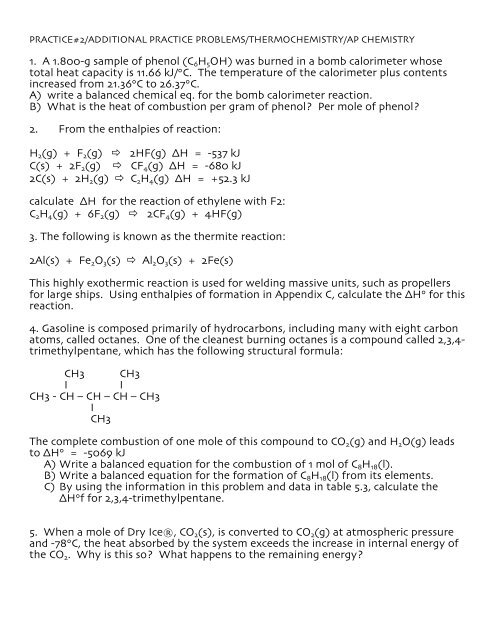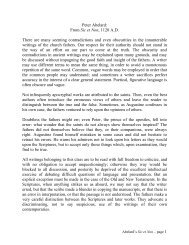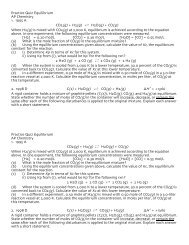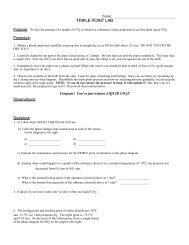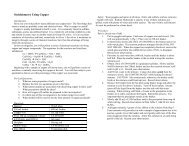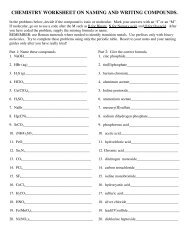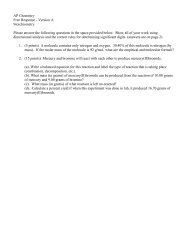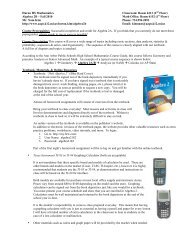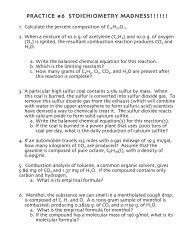1. A 1.800-g sample of phenol (C6H5OH) was burned in a bomb ...
1. A 1.800-g sample of phenol (C6H5OH) was burned in a bomb ...
1. A 1.800-g sample of phenol (C6H5OH) was burned in a bomb ...
You also want an ePaper? Increase the reach of your titles
YUMPU automatically turns print PDFs into web optimized ePapers that Google loves.
PRACTICE#2/ADDITIONAL PRACTICE PROBLEMS/THERMOCHEMISTRY/AP CHEMISTRY<br />
<strong>1.</strong> A <strong>1.</strong>800-g <strong>sample</strong> <strong>of</strong> <strong>phenol</strong> (<strong>C6H5OH</strong>) <strong>was</strong> <strong>burned</strong> <strong>in</strong> a <strong>bomb</strong> calorimeter whose<br />
total heat capacity is 1<strong>1.</strong>66 kJ/°C. The temperature <strong>of</strong> the calorimeter plus contents<br />
<strong>in</strong>creased from 2<strong>1.</strong>36°C to 26.37°C.<br />
A) write a balanced chemical eq. for the <strong>bomb</strong> calorimeter reaction.<br />
B) What is the heat <strong>of</strong> combustion per gram <strong>of</strong> <strong>phenol</strong>? Per mole <strong>of</strong> <strong>phenol</strong>?<br />
2. From the enthalpies <strong>of</strong> reaction:<br />
H2(g) + F2(g) 2HF(g) ∆H = -537 kJ<br />
C(s) + 2F2(g) CF4(g) ∆H = -680 kJ<br />
2C(s) + 2H2(g) C2H4(g) ∆H = +52.3 kJ<br />
calculate ∆H for the reaction <strong>of</strong> ethylene with F2:<br />
C2H4(g) + 6F2(g) 2CF4(g) + 4HF(g)<br />
3. The follow<strong>in</strong>g is known as the thermite reaction:<br />
2Al(s) + Fe2O3(s) Al2O3(s) + 2Fe(s)<br />
This highly exothermic reaction is used for weld<strong>in</strong>g massive units, such as propellers<br />
for large ships. Us<strong>in</strong>g enthalpies <strong>of</strong> formation <strong>in</strong> Appendix C, calculate the ∆H° for this<br />
reaction.<br />
4. Gasol<strong>in</strong>e is composed primarily <strong>of</strong> hydrocarbons, <strong>in</strong>clud<strong>in</strong>g many with eight carbon<br />
atoms, called octanes. One <strong>of</strong> the cleanest burn<strong>in</strong>g octanes is a compound called 2,3,4trimethylpentane,<br />
which has the follow<strong>in</strong>g structural formula:<br />
CH3 CH3<br />
I I<br />
CH3 - CH – CH – CH – CH3<br />
I<br />
CH3<br />
The complete combustion <strong>of</strong> one mole <strong>of</strong> this compound to CO2(g) and H2O(g) leads<br />
to ∆H° = -5069 kJ<br />
A) Write a balanced equation for the combustion <strong>of</strong> 1 mol <strong>of</strong> C8H18(l).<br />
B) Write a balanced equation for the formation <strong>of</strong> C8H18(l) from its elements.<br />
C) By us<strong>in</strong>g the <strong>in</strong>formation <strong>in</strong> this problem and data <strong>in</strong> table 5.3, calculate the<br />
∆H°f for 2,3,4-trimethylpentane.<br />
5. When a mole <strong>of</strong> Dry Ice®, CO2(s), is converted to CO2(g) at atmospheric pressure<br />
and -78°C, the heat absorbed by the system exceeds the <strong>in</strong>crease <strong>in</strong> <strong>in</strong>ternal energy <strong>of</strong><br />
the CO2. Why is this so? What happens to the rema<strong>in</strong><strong>in</strong>g energy?
6. An alum<strong>in</strong>um can <strong>of</strong> a s<strong>of</strong>t dr<strong>in</strong>k is placed <strong>in</strong> a freezer. Later the can is found to be<br />
split open and its contents frozen. Work <strong>was</strong> done on the can <strong>in</strong> splitt<strong>in</strong>g it open.<br />
Where did the energy to accomplish this work come from?<br />
7.A c<strong>of</strong>fee-cup calorimeter conta<strong>in</strong>s 150.0-g <strong>of</strong> water at 25.1°C. A 12<strong>1.</strong>0-g block <strong>of</strong><br />
copper metal is heated to 100.4°C by putt<strong>in</strong>g it <strong>in</strong>to a beaker <strong>of</strong> boil<strong>in</strong>g water. The<br />
specific heat <strong>of</strong> Cu(s) is 0.385 J/gK. The copper is added to the calorimeter and the<br />
temperatures allowed to equilibrate to 30.1°C.<br />
A)<br />
Determ<strong>in</strong>e the amount <strong>of</strong> heat, <strong>in</strong> J, lost by the copper block.<br />
B)<br />
Determ<strong>in</strong>e the amount <strong>of</strong> heat ga<strong>in</strong>ed by the water. The specific heat <strong>of</strong> water is 4.18<br />
J/gK<br />
C)<br />
The difference between your answers for parts a and b is due to the heat loss through<br />
the Styr<strong>of</strong>oam® cups and the heat necessary to raise the temperature <strong>of</strong> the <strong>in</strong>ner<br />
wall <strong>of</strong> the apparatus. The heat capacity <strong>of</strong> the calorimeter is the amount <strong>of</strong> heat<br />
necessary to raise the temperature <strong>of</strong> the apparatus (cups, lid, thermometer) by 1 K.<br />
Calculate the heat capacity <strong>of</strong> the calorimeter <strong>in</strong> J/K.<br />
D)<br />
What would the f<strong>in</strong>al temperature <strong>of</strong> the system be if all <strong>of</strong> the heat lost by the<br />
copper block <strong>was</strong> absorbed by the water <strong>in</strong> the calorimeter?
ANSWERS TO ADDITIONAL PRACTICE PROBLEMS:<br />
<strong>1.</strong><br />
(a) <strong>C6H5OH</strong>(s) + 7O2(g) → 6CO2(g) + 3H2O(l)<br />
(b) q<strong>bomb</strong> = -qrxn; ∆T = 26.37°C – 2<strong>1.</strong>36°C = 5.01°C<br />
q<strong>bomb</strong> = 1<strong>1.</strong>66 kJ/1°C X 5.01°C = 58.417 = 58.4 kJ<br />
At constant volume, qv = ∆E, ∆E and ∆H are very similar.<br />
∆Hrxn = ∆Erxn = qrxn = -qrxn = -58.417 kJ/<strong>1.</strong>800 g <strong>C6H5OH</strong> = -32.454 =<br />
-32.5 kJ/g <strong>C6H5OH</strong><br />
∆Hrxn = -32.454 kJ/1 g <strong>C6H5OH</strong> X 94.11 g <strong>C6H5OH</strong>/1 mol <strong>C6H5OH</strong> =<br />
-3.054 X 10 3 kJ/mol <strong>C6H5OH</strong> = -3.05 X 10 3 kJ/mol <strong>C6H5OH</strong><br />
2.<br />
C2H4(g) 2C(s) + 2H2(g) ∆H = -52.3 kJ<br />
2C(s) + 4F2(g) 2CF4(g) ∆H = 2(-680 kJ)<br />
2H2(g) + 2F2(g) 4HF(g) ∆H = 2(-537 kJ)<br />
C2H4(g) + 6F2(g) 2CF4(g) + 4HF(g) ∆H = -2.49 x 10 3 kJ<br />
3.<br />
Plan: ∆Hrxn = Σn∆H°f (products) - Σn∆H°f (reactants)<br />
∆Hrxn = ∆H°f Al2O3(s) + 2∆H°f Fe(s) - ∆H°f Fe2O3 - 2∆H°f Al(s)<br />
∆Hrxn = (-1669.8 kJ) + 2(O) – (-822.16 kJ) – 2(O) = -847.6 kJ<br />
4.<br />
a) C8H18(l) + 25/2 O2(g) → 8CO2(g) + 9H2O(g) ∆H° = -5069 kJ<br />
b) 8C (solid graphite) + 9H2(g) → C8H18(l) ∆H°f = ?<br />
c) ∆Hrxn° = 8∆Hf CO2(g) + 9∆Hf H2O(g) - ∆Hf C8H18(l) - 25/2 ∆Hf O2(g)<br />
∆H°f C8H18(l) = 8(-393.5 kJ) + 9(-24<strong>1.</strong>82 kJ) + 5069 kJ = -255 kJ<br />
5.<br />
In the process described, one mole <strong>of</strong> solid CO2 is converted to one mole <strong>of</strong> gaseous<br />
CO2. The volume <strong>of</strong> the gas is much greater than the volume <strong>of</strong> the solid. Thus, the<br />
system (the CO2) must work aga<strong>in</strong>st atmospheric pressure when it expands. To<br />
accomplish this work while ma<strong>in</strong>ta<strong>in</strong><strong>in</strong>g a constant temperature requires the<br />
absorption <strong>of</strong> additional heat beyond that required to <strong>in</strong>crease the <strong>in</strong>ternal energy <strong>of</strong><br />
the CO2. The rema<strong>in</strong><strong>in</strong>g energy is turned <strong>in</strong>to work.
6.<br />
Freez<strong>in</strong>g is an exothermic process (the opposite <strong>of</strong> melt<strong>in</strong>g – which is clearly<br />
endothermic). When the system (the s<strong>of</strong>t dr<strong>in</strong>k) freezes, it releases energy to the<br />
surround<strong>in</strong>gs (the can). Some <strong>of</strong> this energy is used to work the can apart (splitt<strong>in</strong>g).<br />
7.<br />
a) qCu = 0.385 J/gK X 12<strong>1.</strong>0 g Cu X (30.1°C - 100.4°C) = -3274.9 = -3.27 X 10 3 J<br />
the negative sign <strong>in</strong>dicates the 3.27 X 10 3 J are lost by the Cu block.<br />
b) qH2O = 4.184 J/gK X 150.0 g H2O X (30.1°C - 25.1°C) = 3138 = +3.1 X 10 3 J<br />
the positive sign <strong>in</strong>dicates that 3.1 X 10 3 J are ga<strong>in</strong>ed by the H2O.<br />
c) The difference between the heat lost by the Cu and the heat ga<strong>in</strong>ed by the water is<br />
3.275 X 10 3 J - 3.3138 X 10 3 = 0.137 X 10 3 = 1 X 10 2 J. The temperature change <strong>of</strong> the<br />
calorimeter is 5.0°C. The heat capacity <strong>of</strong> the calorimeter <strong>in</strong> J/K is<br />
0.137 X 10 3 J X 1/5.0°C = 27.4 = 3 X 10 J/K = 30 J/K<br />
S<strong>in</strong>ce qH2O is known to 1 decimal place, the difference has 1 decimal place and the result<br />
has 1 sig. fig.<br />
If the rounded results from a) and b) are used, Ccalorimeter = 0.2 X 10 3 J/5.0°C = 4 X 10 J/K<br />
d) qH2O = 3.275 X 10 3 J = 4.184 J/gK X 150.0 g X (∆T)<br />
∆T = 5.22°C; Tf = 25.1°C + 5.22°C = 30.3°C


